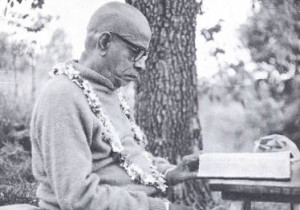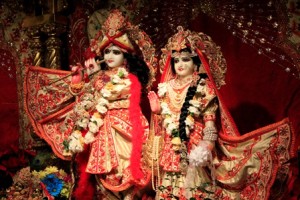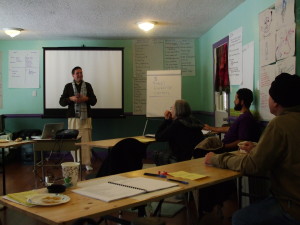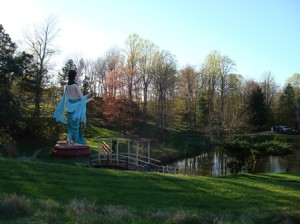New Vrindaban Amid “Transformation of a Spiritual Community”
by Madhava Smullen
New Vrindaban, ISKCON’s first rural community, is in the midst of a major transformation.
When the community was first established under the guidance of ISKCON Founder Srila Prabhupada in 1968, it became, for many years, a shining example of the best that ISKCON had to offer.
Prabhupada would often direct devotees from other newly emerging communities to study what the devotees at New Vrindaban were doing and to follow their lead in areas such as cow-protection and Deity worship. Meanwhile the cooks, jewelry makers, craftsmen and seamstresses were among the best in ISKCON.
After a series of well-documented legal transgressions and spiritual deviations in the 1980s, however, many devotees left. In 1988, New Vrindaban was excommunicated from ISKCON, and remained so for the next decade. But a dedicated core crew stayed on, navigating difficulties year after year, until in 1998 they brought New Vrindaban to the point where it was once again accepted as part of the broader International Society for Krishna Consciousness.
Although various struggles continued, the community gradually began to be known for its efforts to inspire both ISKCON devotees and the general public, with thousands gathering for its Festival of Inspiration, 24-Hour-Kirtan, and Festival of Colors.
In 2011, nearly twenty-five years since they first started, ISKCON New Vrindaban’s legal and financial crises were finally settled. At last, residents and well-wishers could focus on rebuilding their tarnished and tattered community.
To help, the Board Members and GBC brought in Jaya Krsna Das, who took on the role of community president in March 2011. With twenty-five years of experience in the world of business and seven overseeing major growth at Bhaktivedanta College, Belgium, he used his know-how and a bit of inspiration to develop a strong and effective system for New Vrindaban’s transformation.
The idea for the system took birth when, soon after his arrival, a senior devotee gave him a book entitled ‘One Foot Planted in the Center, The Other Dangling off the Edge: How Intentional Leadership Can Transform Your Church,’ by Gordon R. Dragt. The book tells the story of how one Reverend with a vision turned a New York City church with a history of difficulty into a vibrant and successful community.
“The author explained that it takes seven years to make a change like this,” says Jaya Krsna. “Initially I thought the process would go much quicker. But it has become clear to me that a longer effort is required.”
With this in mind, Jaya Krsna developed a system entitled “Transformation of a Spiritual Community.” It comprises six phases stretching out over a seven-year-period, with each phase lasting approximately one year.
The phases are: Analysis, Change, Transition, Stabilization, Deepening Relationships, and Strong Community Spirit and Unity.
During the first phase, Analysis, Jaya Krsna simply tried to serve the devotees of ISKCON New Vrindaban as best he could, incorporating a principle that Gordon R. Dragt calls “paying the rent,” or recognizing and appreciating the positive achievements of the past before breaking new ground.
“There are many senior devotees here who have given decades of their lives to create a national Tirtha, or holy place—to build the temple, the lodge, the Palace of Gold, the cabins by the water, and the cow protection facilities,” he told ISKCON News in 2011, expressing that he saw himself as simply a small instrument in New Vrindaban’s revival. “They’ve lived very simple lives, and have given everything to Srila Prabhupada.”
He added in 2013, “They have created such an infrastructure and such big potential.”
In the Analysis phase, Jaya Krsna also spent time observing the residents of the New Vrindaban community, seeing how the devotees interacted with each other and where there was room for improvement.
“The analysis phase actually continues throughout all the other phases,” he says. “Because nothing is ever perfect in this material world. So we have to constantly try to adjust and to improve. Not that it’s a one time thing, and then everything is fine. It’s a long process, that you have to constantly work on.”
In the second phase, Change, Jaya Krsna’s aim was to create a dynamic and effective structure for ISKCON New Vrindaban that better reflects the current needs of the community members, tourists and pilgrims.
Part of this involved improving the physical infrastructure of the community. After several decades of minimal to no maintenance, full renovations were carried out on the residential ashrams, restaurant, and the guest lodge. Jaya Krsna also created several new departments, including a facilities department that would handle renovations and construction; a festival department to handle New Vrindaban’s many signature festivals; and a department for devotee care and relations.
The next phase in the transformation was Transition, which ISKCON New Vrindaban is currently still in. Over the past few decades, there had never been enough devotees for the community’s vast infrastructure. So Jaya Krsna brought in several new department heads from countries all over the world, including Mauritius, Switzerland, and of course the USA. As well as overseeing the newly added departments, these devotees take care of the Pujari, Palace Lodge, Restaurant, Land Management, Accounting, Palace of Gold, Ladies’ Ashram, and Congregational Development departments.
Having all these different divisions and their heads is important in the effective running of a large community, Jaya Krsna explains, as it frees up the president to care for devotees, build relationships, provide spiritual support, and plan the future course the community will take.
While it will bring on these positive effects, Transition is also the most difficult phase, with some devotees moving on because they did not feel comfortable or find a place within the new vision.
“The transitional phase has been far from perfect,” Jaya Krishna says, admitting that there was sometimes a lack of communication from his side. “As could be expected, it has been painful for everybody.”
ISKCON New Vrindaban’s 2013 Board Meeting from November 8th to 10th went some way towards soothing this pain. The meeting included an open dialogue during which Board members introduced the new department heads and shared the new “Transformation of a Spiritual Community” system with community members. They also pledged to make devotee care and improvement of community spirit top priorities in 2014.
“Since then, I would say that there has been a strong understanding of all the different phases, and a growing support for them, too,” Jaya Krsna says.
By sometime in 2014, he hopes to have successfully completed the Transitional phase, and to move into Stabilization.
“During the transition, everything is new and fragile,” he explains. “You need a phase to solidify the new structure, so that you know it’s grounded, will not fall apart, and will continue into the future. Stabilization is an important phase during which you go deeper and create a proper team spirit and develop a nice service mood amongst devotees.”
In the fifth phase of the transformation, “Deepening Relationships,” Jaya Krsna hopes that the community members of New Vrindaban will see, based on what was achieved in Stabilization, that the change is not a flash in the pan but is here to stay.
He also hopes that by this point newcomers like himself will have soaked up some of the mood of the holy dhama and be able to exchange with its residents in their “Brijbasi Spirit,” best summed up by Srila Prabhupada in a 1973 letter: “Agriculture and protecting cows, this is the main business of the residents of Vrindaban, and above all simply loving Krishna.”
“Once you have deep relationships, the ultimate goal is Strong Community Spirit and Unity,” Jaya Krsna says. “That’s what everyone is looking for. We are all human beings, we need community and relationships. We want to execute Srila Prabhupada’s instructions for New Vrindaban together, as a strong, unified community.”
Srila Prabhupada, of course, famously gave specific instructions for New Vrindaban, and Jaya Krsna feels that upon reaching the end of the seven phases the community will make significant progress in implementing these instructions and will begin to reveal its seemingly unlimited potential.
“I truly believe that New Vrindaban has incredible potential — I see it every day,” he says. “Based upon Srila Prabhupada’s Pushpa Samadhi the Palace of Gold, and upon the infrastructure that we have, I think it can once again be one of North America’s leading ISKCON communities.”







Well done Jaya Krsna prabhu.
It would be good to take this approach to the whole of
our Society. One day hopefully